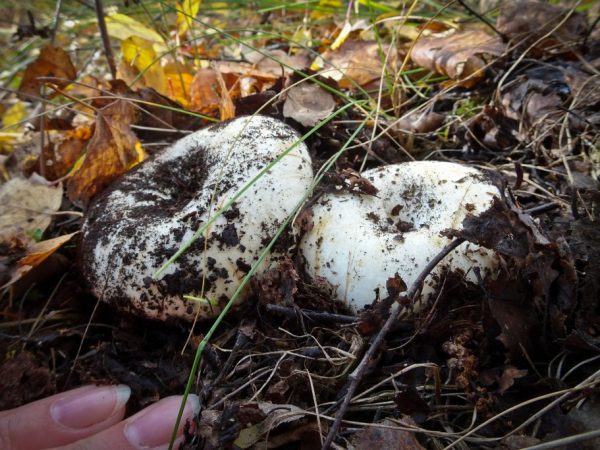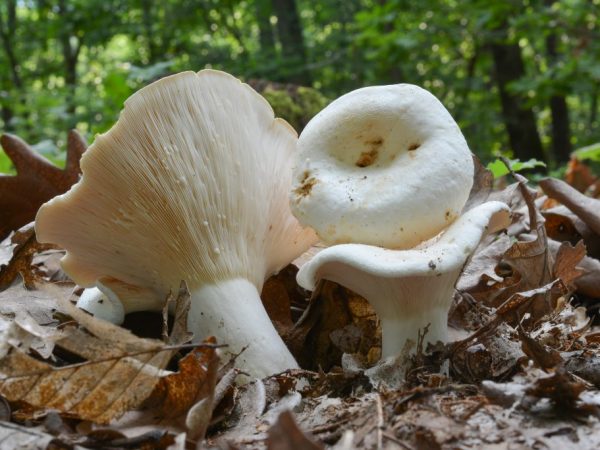Description of the mushroom dry milk
Dry mushrooms are also called white pods. It is quite widespread in Eurasia. It is harvested in forests at the edges or under trees. Half of the body of the fungus is in the soil, while the other half is covered with foliage.

Description of the mushroom dry milk
Description of dry weight
Dry milk mushroom belongs to the russula family. People call it an excellent rusk or russula.
Outwardly, the fruiting bodies resemble ordinary white milk mushrooms, but the surface of their caps is not covered with mucus. The species belongs to the 3rd category of edibility.
Harvested from June to November. Location - all types of forests. Milk forms mycorrhiza (symbiosis of mycelium and plant roots) with a number of trees:
- pine;
- spruce;
- oak;
- birch;
- beech;
- alder;
- aspen.
Irina Selyutina (Biologist):
White pods, as well as milk mushrooms, sometimes help the mushroom picker to "search" for wild boars. Of course, not in the literal sense of the word. It just so happens that, having come to a glade that has long been chosen, the mushroom picker can find the ground completely dug up on it, among the clods of which white hats are clearly visible.
Most common near water bodies. Suitable soil is sod-sandy.
Appearance
| Hat | In a young body it is convex, with a depression in the middle. The edges are down. As it matures, it resembles a funnel, the edges become wavy, the diameter reaches 15 cm. The color of a young mushroom is white, later it turns yellow, brown spots appear. |
| Leg | White color. Has brown spots. Height - up to 5 cm, diameter - up to 3 cm. It becomes narrower to the soil. |
| Pulp | Delicate but fleshy. There is no milky juice. The taste is sweetish. |
| LPs | The color is white, can be blue or green. |
Doubles
Dry milk mushrooms are confused with some types:
- We load it with real, we load it with pepper, a violin, a white wave. Unlike them, there is no milky juice in it.
- Russula pseudo-luxury. It has a yellow cap, grows near oak trees, and is classified as conditionally edible.
- The load is greenish. The main differences from dry weight are in the frequent arrangement of the plates, their well-pronounced bluish-greenish tint, which is better noticeable at the base of the leg. This species is edible.
Irina Selyutina (Biologist):
Despite the presence of several doubles, dry milk mushrooms are still often confused with real, or raw, or white milk mushrooms. To prevent this from happening, you need to remember the main features of a real lump:
- A thin layer of mucus on the surface of the cap.
- Yellowish color of the cap, on which darker concentric zones are visible (although not very strongly).
- The fringe on the cap is noticeable.
- The edges of the cap are strongly curved downward and inward.
- The leg is hollow.
- Abundant acrid white milky juice, which, on contact with air, changes color, becoming sulfur-yellow.
- Smell: real milk mushrooms have a specific aroma with characteristic fruity notes.
When harvesting, the crop is often dug out, because dry milk mushrooms develop in the soil. Fruit bodies immersed in the soil are less likely to be attacked by worms or the development of rot.
The most important feature in the difference between dry milk mushroom and its counterparts from the genus Mlechnik is the presence of milky sap. Therefore, having made a cut, carefully examine it - only the double will have milky juice on it.
Useful and harmful properties
Nutritional value of the mushroom per 100 g:
| Calories | 19 kcal |
| Protein | 1.8 g |
| Fats | Up to 1 g |
| Carbohydrates | 1.1 g |
Dry milk mushrooms have a number of useful properties:
- remove kidney stones;
- are a diuretic product;
- help in the fight against tuberculosis;
- support the immune system;
- activate memory, help to memorize information better;
- improve the functioning of the gastrointestinal tract;
- calm the nervous system (sedative effect);
- maintain insulin levels in the blood;
- cleanse blood vessels;
- tone up the body;
- Are low in calories and high in nutrients
- remove warts;
- improve the quality of hair and skin.

Mushrooms cannot be eaten raw
Contraindications:
- children under 7 years old;
- liver and stomach diseases;
- individual intolerance.
These mushrooms cannot be eaten raw: this will cause severe poisoning. Before use, the product must be carefully processed.
Dry milk mushrooms in cooking
Dry milk mushrooms are used:
- pickled;
- in salty form.
Before cooking, the load (dry milk mushrooms) are soaked in cold water for 5 hours. Then they are boiled in salted water. Then they are again placed in cold water.
Salt in 2 ways:
- Quick: dry milk mushrooms are boiled for 20 minutes, adding salt and spices to taste. Add citric acid or vinegar to prevent fermentation. Put the mushrooms in a bowl of cold water to cool. After 10-15 minutes they will be ready to eat.
- For long-term storage: place the mushrooms in several layers in a dish suitable for this purpose. If you take an enamelled container, it should not have enamel chips. Each layer is salted and poured with water at the end. The product is left under water, transferred to a place with room temperature. When the foam stops forming, the product is washed. Mushrooms are laid out in containers (jars) and filled with salt water. Storage conditions - cold place. A refrigerator or cellar is suitable.
Dry milk mushrooms are frozen for the winter. Use only the product itself, water and salt. Initially, the mushroom is soaked, cut into cubes and boiled. For 1 liter of water add 1 tbsp. l. salt. Before the water boils, you can add citric acid on the tip of a knife.
Cook for up to 20 minutes, constantly skimming off the foam. Next, the mass is dried and laid out either in jars, or in bags, or in special containers. Store in the freezer for up to 10 months.
Caviar from podgruzdki
Ingredients:
- mushrooms - 2 kg;
- carrots - 0.5 kg;
- onions - 0.5 kg;
- pepper;
- salt;
- vinegar 6% - 5 tbsp. l .;
- vegetable oil.
Initially, vegetables are peeled, washed and ground. They are fried in a skillet with vegetable oil and poured into a saucepan to stew.
Podgruzdki cut into small pieces or use a meat grinder Pour the mass to vegetables, pour in 0.5 tbsp. l. vegetable oil, stew for 40 minutes, stirring occasionally.
Add spices and simmer for another 10 minutes. At the end, add vinegar, stir and immediately pour the mass into the jars. Roll up, allow to cool and move to a cold, dark place.
Pickled mushrooms in tomato
For cooking, you need the following ingredients:
- water - 500 ml;
- bay leaf - 2 pcs.;
- vinegar - 2 tbsp. l .;
- spices to taste;
- garlic - 2-3 cloves;
- vegetable oil;
- tomato juice, or paste, or ketchup - 250-350 g;
- mushrooms - 1.5 kg.
The main product is fried, add ketchup, tomato paste or juice, water, mix. Then add spices and garlic passed through a press. Laurel leaves are thrown. Stew for 0.5 h, then pour in vinegar. Stew for another 10 minutes, remove bay leaves from the container. The mass is distributed over sterilized jars, leaving a free space of 1.5 cm from the neck of the jar. Sterilize 0.5 liter cans for 40 minutes, 1 liter cans - 1 hour and then roll up.The cooled dish is transferred to a cool and dark place.
Conclusion
Dry mushrooms grow in all types of forests. It is often confused with a violin and a load of pepper. He has no milky juice. Basically, the mushroom is prepared in two ways: pickled and salted. Less often - fried and stewed, necessarily pre-processed. It is perfect for winter harvesting.



